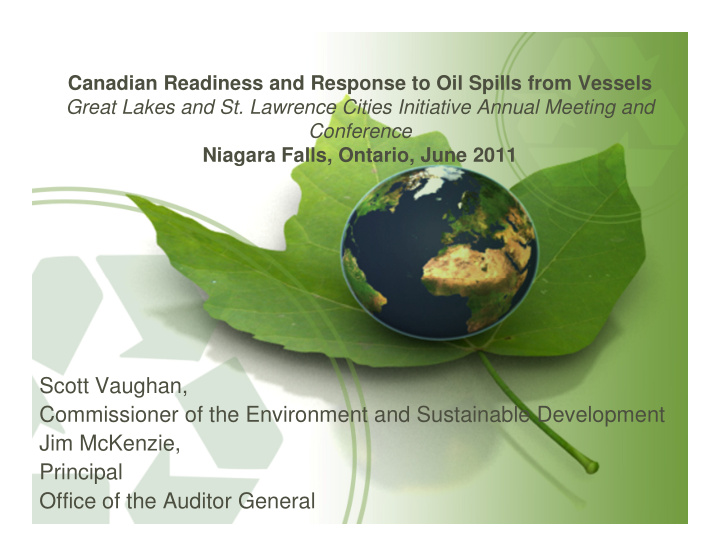



Canadian Readiness and Response to Oil Spills from Vessels Great Lakes and St. Lawrence Cities Initiative Annual Meeting and Conference Niagara Falls, Ontario, June 2011 Scott Vaughan, Commissioner of the Environment and Sustainable Development Jim McKenzie, Principal Office of the Auditor General
Our Mandate • Examine government of Canada environmental protection and sustainability programs and report to Parliament of Canada Canada • Provide independent, objective and evidence-based reports, to enable Parliament to hold the government to account
What We Examined? • December 2010 -- Oil Spills from Ships • Examined spill preparedness and response from all types of spills, including oil and other spills (including hazardous and noxious spills (including hazardous and noxious substances) • Examined the federal regime in Canada, comprised of the Canadian Coast Guard, Transport Canada and Environment Canada • Did not examine prevention and detection
Why It Matters • Spills can have an immediate and long- term impacts -- marine life, economic viability from jobs to tourism viability from jobs to tourism
Why It Matters • In Canadian waters, spills are not a rare event: • 2007-2009 -- over 4,160 pollution incidents reported to the Canadian Coast Guard – Of these, 1,580 involved oil spills from ships. – Of these, 1,580 involved oil spills from ships. – 25 percent of total reported spills were reported in the Great Lakes and St. Lawrence regions – According to data from the Canadian Coast Guard, approximately one third of the total reported incidents involved a spill response using regional resources – Hard to know exactly the significance of spills due to poor data
Who Does What – the Federal Regime • After the 1989 Exxon Valdez, the federal government began and review and adopted a new regime 1995 • Need to know who has the lead in an • Need to know who has the lead in an emergency • Federal regime consists of Transport Canada, Canadian Coast Guard, Environment Canada • Response Organizations
Response Agreements Response time requirements for certified response organizations Policy question raised by Parliamentarians: are response times sufficient given potential impacts (especially for large spills)?
What We Found – Emergency Planning and Risk Assesment • First, not all emergency response plans are up- to-date: – The national plan for the Canadian Coast Guard done in 1998; Environment Canada’s -- Guard done in 1998; Environment Canada’s -- 1999. – Need plans that are up-to-date and supported by equipment, training and exercises. – Some regional plans more up-to-date than others. Central and Arctic Region – covering Great Lakes – updated in 2008; Quebec Region updated in 2009
What We Found – Emergency Planning and Risk Assesment • Second: knowing and responding to risks – The federal regime lacks a systematic approach to assess risks – the last national risk assessment was done in 2000. risk assessment was done in 2000. – Risks evaluated off south coast of Newfoundland, which is a high volume area for tankers
What We Found – Oil Spill Response Equipment • The Canadian Coast Guard has found through its own internal assessments that much of its emergency response equipment is out-of-date equipment is out-of-date • Old is not necessarily bad -- but -- need system to maintain equipment – internal evaluation raises doubts that this is working
What We Found – Oil Spill Response Equipment • Positive Steps: Some new approaches and procurement – New pollution response barges – New emergency response equipment in the – New emergency response equipment in the North combined with rapid deployment plans. – New funding does not however cover costs for operations and maintenance which puts pressure on existing resources. – Set up training with local communities in the North.
What We Found – Training and Exercises • No national training program for oil spill response. • Instead, each region has their own training. • Limited national exercises. Recent table-top exercise for a major oil spill of national significance identified gaps. • Cooperation and joint exercises between the Canadian • Cooperation and joint exercises between the Canadian and US Coast Guards, for instance in the Great Lakes (CANUSLAK). • But no inter-regional exercises within Canada, for example between the Atlantic and Quebec region. If a major spill occurred within Canada, lack of training and exercises between regions could have an impact
What We Found – Training and Exercises Exhibit 1.4—Responders need to be familiar with the many techniques used to contain oil spills
Finally, Hazardous and Noxious Substances • High, and increasing volume of HNS shipments raises risk of major chemical spill in Canadian waters • Windsor, Hamilton and Montreal identified as high-risk ports • At the international level, the International Maritime Organization has a protocol to address the treatment of ship source chemical spills spills • Protocol requires calls for a national response system, including a designated national authority, a national contingency plan, response equipment, communications plans, and regular training and exercises • Canada has not adopted the Protocol, and will have no regime in place until 2013. • In the interim, Canada lacks a formal framework for responding to ship-source chemical spills including clear roles and responsibilities.
Sum Up • Update emergency response plans, and put them in practice through exercises • Update risk assessments, to understand changing risks changing risks • Training is important for readiness • Regime for dealing with HNS incidents still outstanding
Recommend
More recommend